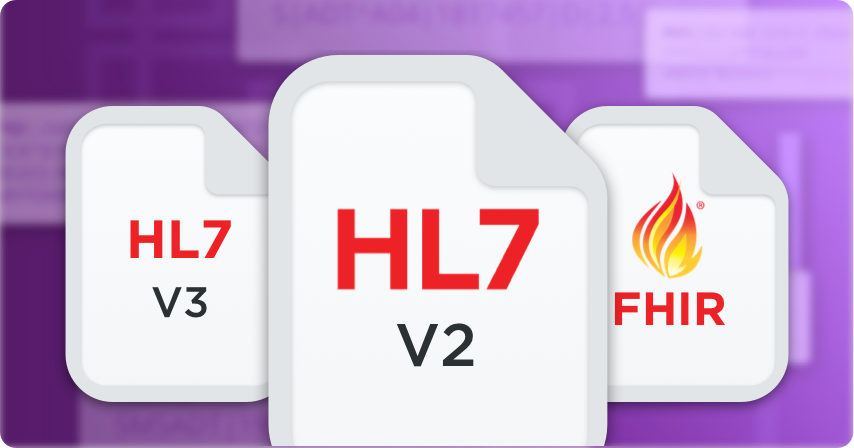Exploring HL7 v2 vs. v3: Which Standard is Right for Your Integration Needs?
- 1 What is HL7?
- 2 Evolution from HL7 v2 to v3
- 3 HL7 v2: Key Attributes
- 3.1 Event-Driven Messaging
- 3.2 Delimited Syntax
- 3.3 Adaptable Framework
- 3.4 Broad Adoption
- 3.5 Challenges with Consistency
- 4 HL7 v3: Key Attributes
- 4.1 Information Model-Based
- 4.2 XML-Based Syntax
- 4.3 Reference Information Model
- 4.4 Standardization and Rigor
- 4.5 Steeper Learning Curve
- 5 Key Differences Between v2 and v3
- 6 Integration Considerations
- 6.1 Understanding Organizational Needs
- 6.2 Technical Expertise
- 6.3 Compatibility with Existing Systems
- 6.4 Scalability and Future Growth
- 6.5 Cost Implications
- 6.6 Stakeholder Communication
- 7 Summary
HL7 is a standard developed and overseen by Health Level Seven. The ANSI recognizes this organization as an official standard-setter in the healthcare domain. This standard primarily falls into two main segments: Version 2 and Version 3. Most HL7 communication today utilizes versions 2.3 or 2.3.1 of this standard. Though there are newer iterations like V3, they make up a smaller fraction of real-world interface applications. Additionally, HL7 is working on introducing another standard named HL7 FHIR.
The ARRA/HITECH legislation endorsed HL7 version 2.5.1 to fulfill certain certification criteria. The Consolidated CDA, a component of the V3 standard, received a similar endorsement.
What is HL7?
HL7 ensures seamless communication between health information systems from various vendors and across diverse healthcare settings.
The name “HL7” stands for developing seven layers of standards. The most important one is the application layer. It ensures that data shared between computer programs in healthcare is accurate. This layer plays a big role in tasks like patient registration, handling lab results, and billing.
HL7 is the foundation for a system that eases the exchange, integration, sharing, and retrieval of health data. As EHRs become more common and the need for fast data sharing grows, HL7 standards play a vital role in enhancing the interoperability of health information technologies.
Evolution from HL7 v2 to v3
When comparing HL7 v2 vs. v3, it’s evident that there has been a major shift in how healthcare data is exchanged. HL7 v2 uses an event-driven messaging method and relies on a format similar to CSV files. Its versatility has made it widely used in many healthcare systems. However, this adaptability can sometimes lead to uncertainties in how data is understood across different platforms.
HL7 v3 uses a model-based approach with XML for data representation. This design integrates the Reference Information Model (RIM) to ensure a consistent structure. While the strict guidelines of v3 may pose initial challenges, its commitment to standardization makes it a great option for systems that want dependable data exchanges.
HL7 v2: Key Attributes
When we explore the landscape of healthcare data standards, HL7 v2 stands out as a pivotal cornerstone. It has been fundamental in shaping how health data is exchanged. Let’s explore its defining characteristics:
Event-Driven Messaging
At its core, HL7 v2 is an event-driven messaging protocol. It responds to specific events in healthcare, like patient registration or lab results, to start sharing data.
Delimited Syntax
One standout feature of v2 is its delimited syntax, which resembles CSV files. It employs special characters to separate data elements in messages.
Adaptable Framework
HL7 v2’s design encourages adaptability. It provides the foundation for data exchange but allows for variations in its implementation. This flexibility has made it a favorite among healthcare systems that need customization.
Broad Adoption
Owing to its adaptability and simpler structure, HL7 v2 has seen extensive implementation. It is among the most recognized and used standards in many healthcare data exchange situations today.
Challenges with Consistency
However, this adaptability can sometimes be a double-edged sword. The flexibility of HL7 v2 may lead to inconsistencies across systems due to the varied interpretations of its standards.
HL7 v3: Key Attributes
HL7 v3 marks a big step toward making healthcare data exchange consistent and reliable. Let’s take a closer look at the defining features of this version:
Information Model-Based
HL7 v3 relies on an information model, guaranteeing standardized and uniform data structures. This model-based approach facilitates clear and consistent communication across different platforms.
XML-Based Syntax
Switching to XML as the main language for data in v3 shows its alignment with modern data processing standards. This change enhances compatibility with today’s technologies and ensures an organized data exchange.
Reference Information Model
RIM acts like a backbone, offering a consistent structure. It ensures uniform implementations, regardless of where or how it’s applied.
Standardization and Rigor
HL7 v3 comes with a more stringent set of rules. This rigor ensures that there’s minimal variation in its application. It leads to more consistent and reliable data exchange across systems.
Steeper Learning Curve
HL7 v3’s precision and structure are praiseworthy. Yet, they require a deeper understanding and expertise for effective implementation.
Key Differences Between v2 and v3
HL7 standards enhance healthcare data exchange, but their approaches differ considerably. Here are the fundamental distinctions between the HL7 v2 vs. v3:
Messaging Approach
V2 operates on an event-driven messaging system, reacting when specific healthcare events occur. In contrast, v3 is based on an information model, ensuring a standardized pattern for all data exchanges.
Syntax and Structure
V2 adopts a delimited syntax reminiscent of CSV files, providing flexibility at the risk of inconsistencies. v3 opts for XML for its data representation. This choice brings v3 in line with modern data processing standards and ensures a uniform structure.
Flexibility vs. Rigor
V2 is known for its adaptability, enabling healthcare systems to customize their data processes. However, this flexibility can sometimes result in varied interpretations of the standard. On the other hand, v3 places a strong emphasis on standardization. Its stringent guidelines guarantee minimal variation in its application, promoting uniform data exchange across platforms.
Implementation Curve
Thanks to its simpler design, many organizations find v2 easier to adopt and integrate. v3, with its detailed precision and structure, demands a deeper understanding. Its onboarding process becomes more intricate.
Integration Considerations
When an organization begins integrating HL7 v2 vs. v3 standards, certain factors come to the forefront to ensure a seamless and efficient process.
Understanding Organizational Needs
Before deciding between v2 and v3, it’s crucial to assess your organization’s specific requirements. Are you looking for adaptability to suit unique data processes, or is a standardized, rigorous framework more aligned with your vision?
Technical Expertise
The integration of HL7 standards demands a certain level of technical expertise. While v2 might be more straightforward, v3’s intricacies require a deeper understanding. It’s essential to assess whether your team possesses the necessary skills or if external expertise is necessary.
Compatibility with Existing Systems
Assessing the compatibility of your healthcare systems with the chosen HL7 standard is crucial. Some legacy systems might be more attuned to v2, while modern infrastructures could lean towards the structured approach of v3.
Scalability and Future Growth
Think about where your organization is headed in the future. If it expects significant growth, v3’s standardized approach may provide greater long-term advantages. But, if your focus is on specialized, niche areas, v2’s flexibility might be more beneficial.
Cost Implications
Implementing new standards can come with various costs, both immediate and long-term. These costs encompass technology expenses, training, maintenance, and potential future adjustments. Conducting a cost-benefit analysis can be a valuable tool in the decision-making process.
Stakeholder Communication
Keeping stakeholders in the loop is paramount. Consistent communication ensures everyone is aligned with the integration’s goals and processes.
Summary
HL7 v3 builds upon the foundation laid by HL7 v2, enhancing its capabilities. v3 incorporates reusable structures and well-defined data types using a recognized syntax-encoding industry standard.
HL7 v3 can handle and convey complex medical data, making it especially apt for organizational exchanges. Yet, this sophistication introduces a heightened level of complexity.
On the other hand, HL7 v2 was designed with simpler data exchanges in mind. It can be less suitable for scenarios that demand the communication of intricate medical information.

















